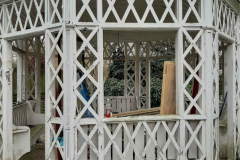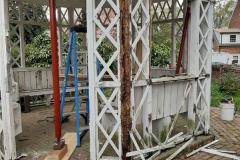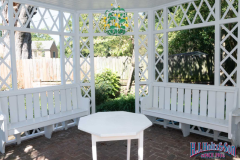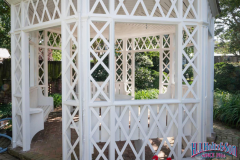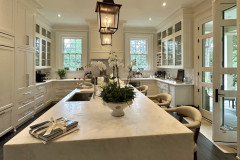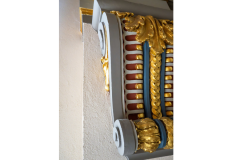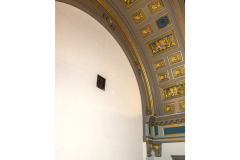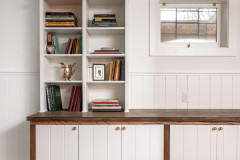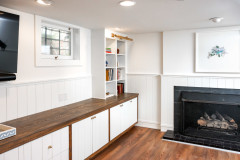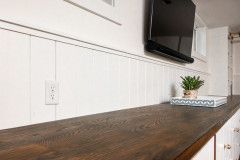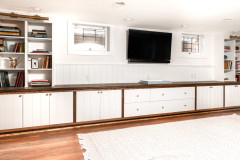
by HJ HOLTZ | Apr 16, 2024 | Historic Restoration, Carpentry Services, Residential Painting
Every year, the Garden Club of Virginia’s Historic Garden Week in Virginia demonstrates the power of “curb appeal” – the term often used to refer to the aesthetics of a property’s exterior. H.J. Holtz & Son understands the importance of that initial impression.
“There’s so much to think about outside,” says company President Rick Holtz. “Shutters, windows, trim, and doors – these are all obvious. But you also have fences, railings, porches, benches, even outbuildings. Sometimes, homeowners don’t consider those elements, because they’re so focused on the inside, but that’s what people see first.”
For 2024’s tour, Holz & Son worked at 4601 Lilac Lane, where on April 23 ticket-holders will be able to tour nearly four acres of garden and farm, tucked inside Richmond’s city limits. The homeowners, longtime Holtz clients, had the company repaint shutters and doors as well as paint the entire pool house. Tour participants on April 25 will be able to see 109 Nottingham Road, which has a fresh, Holtz-painted front door covered in a Fine Paints of Europe coating.
Not everyone has a house that will someday be featured on a Historic Garden Week tour, but an exterior assessment to take stock of what might need a refresh is recommended at least once a year. Outdoor surfaces are subjected to greater wear and tear than indoor spaces, thanks to the effects of sun, wind, precipitation, and even bugs and wildlife. With an in-house carpentry division, Holtz & Son is often able to repair or replace damaged wood, so a separate contractor isn’t necessary.
“In the past, we’ve rebuilt an entire gazebo, and we regularly fix railing posts and fences,” Holtz says. “Our carpentry team works both on-site and in our new expanded shop, which allows them to manage multiple jobs at a time with greater efficiency.”
To schedule an evaluation of your home’s exterior, call H.J. Holtz & Son, 804-358-4109.
Sponsored by the Garden Club of Virginia, Historic Garden Week dates to 1929, when it began as a way to raise money for historic Kenmore, the Fredericksburg home of Betty Washington Lewis, George Washington’s sister. Funds raised support the ongoing restoration and preservation of Virginia’s historic public gardens and landscapes across the state as well as a research fellowship program in landscape architecture.
For more information about Historic Garden Week or to purchase tickets, visit https://www.vagardenweek.org/.

by HJ HOLTZ | Apr 4, 2024 | Historic Restoration, Furniture and Cabinetry, Residential Painting
The spectacular properties featured during Historic Garden Week have been prepped for a year or more for their time in the spotlight. Participating homeowners know that hundreds of people are eager to see meticulous gardens and plantings as well as pristine interiors filled with floral arrangements created by the state’s garden club members. Nearly every year, H.J. Holtz and Son helps to ensure those spaces look their best by providing interior painting, exterior painting, custom cabinetry, and cabinetry painting.
“We’re always happy to assist an existing or new client who’s getting their house ready for the tour,” says company president Rick Holtz. “Sometimes, it’s a small project, like painting the front door and shutters, but other times, the homeowner realizes that they want a full interior refresh.”
Timing is everything when it comes to getting ready for a big event, whether it’s Historic Garden Week, or any special event. “We always encourage people to call us as soon as they have a date in mind,” Holtz says. “Our calendar typically fills quickly, but we want to help repeat customers when we can, and sometimes we have an unexpected opening. And we’re diligent to make sure we hit deadlines.”
Crews have been hard at work for weeks to ensure Holtz client homes are ready for this year’s Richmond dates: Tuesday, April 23, in Windsor Farms-Nottingham; Wednesday, April 24, in River Hill; and Thursday, April 25, in Windsor Farms-Coventry. Visitors will see Holtz handiwork in homes on both the April 23 and 25 tours.
Tuesday, April 23
Windsor Farms – hosting two tours this year – was envisioned in the early 1920s as an upscale residential neighborhood away from the grittiness of the city. Designed in an English garden style popular at the time, the carefully plotted area features many historic homes that have been thoughtfully modernized.
At 209 Nottingham Road, Holtz & Son team members painted cabinets in advance of Historic Garden Week for a new client. At 4601 Lilac Lane, where only the exterior gardens are open for the tour, the Holtz team did exterior painting on the pool house and main residence shutters and doors.
Thursday, April 25
On this second day in Windsor Farms, visitors will encounter varied architectural styles, including English Tudor, Storybook or Cotswold, and European Revival.
At 4300 Dover Road, Holtz team members painted both the dining and living rooms as well as two interior fireboxes with high heat paint. At 4500 Coventry Road, the team hung new wallpaper in the den and painted several chairs in the shop. Projects at 109 Nottingham Road included painting the front door, crown moldings, windows and trim. Holtz craftspeople also installed wallpaper in both the living room and family room, and painted in those rooms as well. The living room also features a Holtz Built cabinet.
Sponsored by the Garden Club of Virginia, Historic Garden Week dates to 1929, when it began as a way to raise money for historic Kenmore, the Fredericksburg home of Betty Washington Lewis, George Washington’s sister. Since then, the tour has been canceled only twice: once during World War II and in 2020, due to the COVID pandemic. Funds raised support the ongoing restoration and preservation of Virginia’s historic public gardens and landscapes across the state as well as a research fellowship program in landscape architecture.
For more information about Historic Garden Week or to purchase tickets, visit https://www.vagardenweek.org/.

by HJ HOLTZ | Mar 19, 2024 | Historic Restoration, INTERIOR PAINTING
The H.J. Holtz & Son team believes that every structure, no matter what its use or purpose, deserves to be cared for and painted well. So when officials from Richmond’s Cathedral of the Sacred Heart called with a significant painting and restoration need, it was easy to say “Yes.”
The company recently repainted theMhistoric church’s choir loft, a commanding space that overlooks the sanctuary below. Soon, a new organ from Canada-based Juget-Sinclair Organbuilders of Montreal will be installed, and the church wanted the space to be ready.
“We learned a lesson” years ago, after flaking ceiling paint threatened to damage the pipes of another Juget-Sinclair organ at the front of the church, says John Marike, the church’s facilities manager. To remedy that problem, the organ manufacturer added fine wire mesh coverings to the pipe openings.
Seeking to avoid a similar post-installation fix for the new organ at the rear of the sanctuary, church administration hired H.J. Holtz & Son following a competitive bid process. Using a framework constructed by Scaffolding Solutions to reach every inch of the curved ceiling – which peaks 34 feet above the balcony floor – up to five Holtz team members could work at the same time. The team repainted the loft’s plaster walls and ceiling, and also repainted the wood of the choir loft railing, banisters and half the wall paneling.
Selecting colors for the choir loft was a critical element of the job, as they needed to match the remainder of the sanctuary, which will be repainted in the future, Marike says. The Cathedral of the Sacred Heart is more than 100 years old; it’s recognized as a Virginia Historic Landmark and is on the National Register of Historic Places. With an Italian Renaissance Revival style, the cathedral’s interior is impressively ornate. Its soaring ceiling has many architectural elements for visual interest – rosettes, scrolls, faux mirrors, etc. And there are multiple paint colors, including a shiny faux gold leaf, for added impact.
“The Holtz team’s attention to detail was great,” Marike says. “The colors were so hard to match, and they really worked hard to get them right.”
Marike credits the team’s determination to stay on schedule, even with interruptions for regular midday church services and funerals that naturally occur without much warning.
“Even with interruptions, they still managed to finish ahead of schedule,” he says.
Next up on the schedule: the new organ!

by HJ HOLTZ | Mar 4, 2024 | Carpentry Services, Residential Painting
Only one thing can detract from a beautifully painted home exterior: shabby windows. That’s why H.J. Holtz & Son has extended its services to include full window restoration.
“We see this as a need for our customers,” says company President Rick Holtz. “We have the expertise when it comes to painting and carpentry; all we needed to do was apply those skills to windows.”
The Holtz carpentry division has added staff in recent years, enabling the company to increase its wood restoration and repair capabilities. The ability to offer those services has proved especially useful for older homes, which most often need carpentry repair throughout the structure. Because windows involve the joining of glass to wood, they are especially vulnerable to temperature swings, weather ranging from severe summer storms to freezing winter precipitation, and even blunt force (think tree limbs or hurled balls). Without careful monitoring, windows will, quite literally, fall apart.
Before beginning any exterior painting job, a Holtz project manager completes a thorough inspection, looking for any areas showing damage that can include wood rot, mold or organic growth, or any other harm that should be repaired before painting can begin. That inspection includes the windows, when the need for window restoration might be identified.
“We don’t want to overlook any issue,” Holtz says.
Sometimes, only one window needs attention, but if your house has original wood windows that are more than 30 years old, it’s likely they all need work. The glazing – the putty that holds the glass in the sash – breaks down over time. Without a solid seal, moisture and even bugs can make inroads, leading to the need for larger repairs or replacement.
With an expanded work space in the company’s new location in Chesterfield, the Holtz carpentry team is able to efficiently manage even large jobs. The first step in window restoration is to bring the windows to the shop, where they are disassembled. The sashes are stripped of paint and any necessary repairs are made. Then the window is reassembled, primed, and painted. The team then replaces or reinstalls the glass, reglazing with fresh putty for a thorough seal. Special care is taken during the priming stage to prevent mold growth, as the primer used provides a line of defense against encroaching moisture. The team can also improve the window’s pulley system by replacing original rope with a metal chain, making it easier to open and close the window.
The team is currently working with a general contractor who is restoring a home nearing its centennial. The owner wanted to keep the original windows for historical accuracy, so Holtz carpenters are fixing and repainting all 50+ windows.
“It’s a privilege for us to help return this house to pristine condition,” Rick Holtz says. “We are so happy to have the in-house expertise that’s needed to maintain the authenticity of these windows while ensuring they remain fully functional for years to come.”
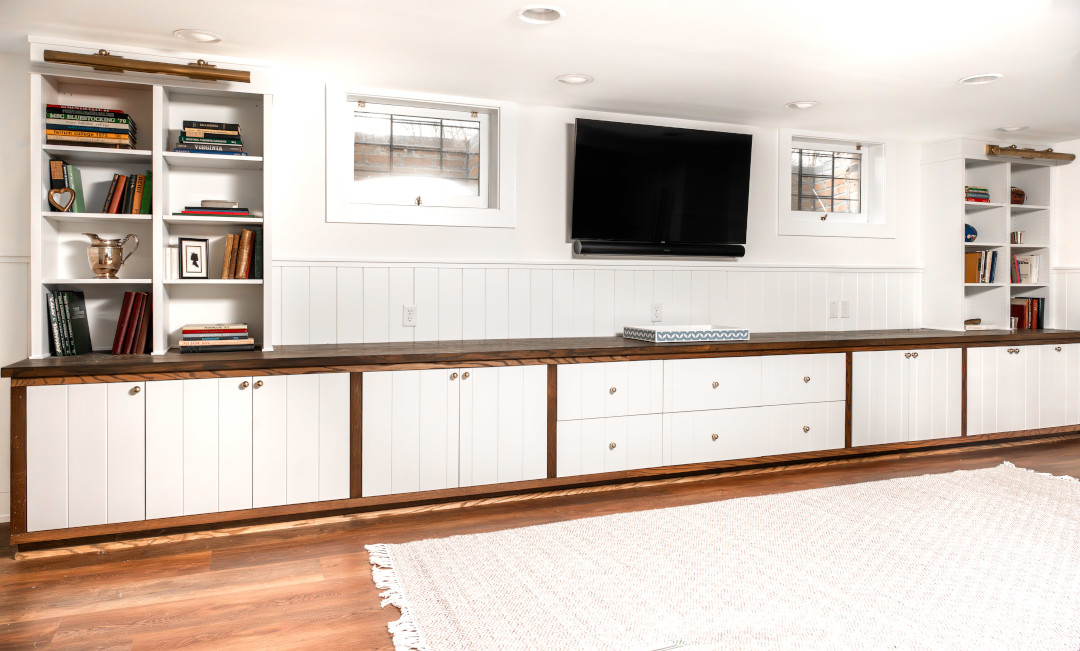
by HJ HOLTZ | Feb 22, 2024 | Carpentry Services
Anne Pulliam, principal of Anne Pulliam Interiors in Richmond, knows she can turn to H.J. Holtz & Son when she wants something done right.
“I’ve been burned before, so it’s worth waiting for Holtz,” she says.
Last year, while visiting the company’s offices for a project, Pulliam happened upon the carpentry shop. Noticing work in progress, she realized the Holtz team could fashion a custom cabinet for her parents’ home.
Pulliam’s parents last renovated their house 25 years ago. With the passage of time and changes in how they use the space, they needed a refresh and asked their daughter to help. The lower level was a particular challenge because there were differences in opinion over how the space could be best used.
“The basement was cheap and cheerful, with wall-to-wall carpet from when we were little,” Pulliam laughs. “It was functional but not aesthetically pleasing; it had served its purpose. [In the recent renovation], Mom wanted it to become a welcoming space where the grandkids could play and keep their toys. Dad wanted it to be clean and masculine, where he could play pool or watch football games with friends.”
Pulliam’s solution was to fill a full wall – nearly 25 feet long – with Holtz Built cabinetry designed to accommodate the twin goals of being both attractive and functional. The base cabinets were built in sections, so they could be easily moved into the room. The top, face frames, and waterfall side are oak. The doors are solid poplar with a V groove cut to match the tongue-and-groove wall paneling throughout the room. The upper towers are plywood and poplar.
Pulliam says her parents weren’t sure the basement warranted the effort.
“They wanted something nice, but wondered if they really wanted to do something this unexpected,” Pulliam says. “I assured them that to get the look they wanted – for the space to not look and feel like a basement – that a little visual interest and a little more character can go a long way.”
The details are essential, she adds, pointing to the toe-kick front base, the “waterfall” oak end, and how the oak was stained to match the vinyl flooring that has the look of hardwood. “This feels like a furniture piece, not just a box that sits on the floor,” Pulliam notes.
Now, her parents are enthusiastic about the custom cabinet unit, which offers both storage and display space for college yearbooks, memorabilia, and toys, and provides an appealing surround for a wall-mounted television.
“Initially, I didn’t know who to turn to for the cabinet construction,” Pulliam says. “But the Holtz team said they could do it, and they solved a lot of problems I didn’t anticipate. All of the craftsmanship really makes a difference.”


